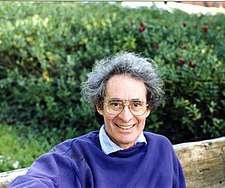Barry Mazur
Barry Charles Mazur (/ˈmeɪzʊr/; born December 19, 1937) is an American mathematician and the Gerhard Gade University Professor at Harvard University.[1][2] His contributions to mathematics include his contributions to Wiles's proof of Fermat's Last Theorem in number theory, Mazur's torsion theorem in arithmetic geometry, the Mazur swindle in geometric topology, and the Mazur manifold in differential topology.
Barry Charles Mazur | |
|---|---|
 Barry Mazur in 1992 | |
| Born | December 19, 1937 |
| Nationality | American |
| Alma mater | Princeton University |
| Known for | diophantine geometry generalized Schoenflies conjecture Mazur swindle Mazur's torsion theorem |
| Awards | National Medal of Science (2011) Chauvenet Prize (1994) Cole Prize (1982) Veblen Prize (1966) |
| Scientific career | |
| Fields | Mathematics |
| Institutions | Harvard University |
| Doctoral advisor | Ralph Fox R. H. Bing |
| Doctoral students | |
Life
Born in New York City, Mazur attended the Bronx High School of Science and MIT, although he did not graduate from the latter on account of failing a then-present ROTC requirement. Regardless, he was accepted for graduate studies at Princeton University, from where he received his Ph.D. in mathematics in 1959 after completing a doctoral dissertation titled "On embeddings of spheres."[3] He then became a Junior Fellow at Harvard University from 1961 to 1964. He is the Gerhard Gade University Professor and a Senior Fellow at Harvard. He is the brother of Joseph Mazur.
Work
His early work was in geometric topology. In an elementary fashion, he proved the generalized Schoenflies conjecture (his complete proof required an additional result by Marston Morse), around the same time as Morton Brown. Both Brown and Mazur received the Veblen Prize for this achievement. He also discovered the Mazur manifold and the Mazur swindle.
His observations in the 1960s on analogies between primes and knots were taken up by others in the 1990s giving rise to the field of arithmetic topology.
Coming under the influence of Alexander Grothendieck's approach to algebraic geometry, he moved into areas of diophantine geometry. Mazur's torsion theorem, which gives a complete list of the possible torsion subgroups of elliptic curves over the rational numbers, is a deep and important result in the arithmetic of elliptic curves. Mazur's first proof of this theorem depended upon a complete analysis of the rational points on certain modular curves. This proof was carried in his seminal paper "Modular curves and the Eisenstein ideal". The ideas of this paper and Mazur's notion of Galois deformations, were among the key ingredients in Wiles's proof of Fermat's Last Theorem. Mazur and Wiles had earlier worked together on the main conjecture of Iwasawa theory.
In an expository paper, Number Theory as Gadfly,[4] Mazur describes number theory as a field which
"produces, without effort, innumerable problems which have a sweet, innocent air about them, tempting flowers; and yet... number theory swarms with bugs, waiting to bite the tempted flower-lovers who, once bitten, are inspired to excesses of effort!"
He expanded his thoughts in the 2003 book Imagining Numbers[5] and Circles Disturbed, a collection of essays on mathematics and narrative that he edited with writer Apostolos Doxiadis.[1]
Awards and honors
In 1982 he was elected a member of the National Academy of Sciences, and in 2012 he became a fellow of the American Mathematical Society.[6]
Mazur has received the Veblen Prize in geometry, the Cole Prize in number theory, the Chauvenet Prize for exposition,[4] and the Steele Prize for seminal contribution to research from the American Mathematical Society. In early 2013, he was presented with one of the 2011 National Medals of Science by President Barack Obama.[7]
Publications
Books
- Mazur, Barry; Stein, William (2016). Prime numbers and the Riemann hypothesis. New York, NY: Cambridge University Press. ISBN 9781107499430.
- Mazur, Barry; Jean-Pierre, Serre, eds. (2016). Collected works of John Tate : parts i and ii. American Mathematical Society. ISBN 0821890913.
- Mazur, Barry (2003). Imagining numbers : (particularly the square root of minus fifteen). New York: Farrar Straus Giroux. ISBN 0312421877. MR 1950850.
- Katz, Nicholas M.; Mazur, Barry (1985). Arithmetic moduli of elliptic curves. Annals of Mathematics Studies, 108. Princeton University Press. ISBN 0-691-08349-5. MR 0772569.
References
- Hoffman, Jascha (2012). "Q&A: The maths raconteur, Barry Mazur". Nature. 483 (7390): 405. doi:10.1038/483405a.
- Barry Mazur at the Mathematics Genealogy Project
- Mazur, Barry Charles (1959). On embeddings of spheres.
- Mazur, Barry (1991). "Number Theory as Gadfly". Amer. Math. Monthly. 98: 593–610. doi:10.2307/2324924.
- Mazur, Barry (2004). Imagining numbers: (particularly the square root of minus fifteen). New York: Penguin Books. ISBN 0-14-100887-3.
- List of Fellows of the American Mathematical Society, retrieved 2013-02-04.
- "3 local professors to get US honors". Boston Globe. 7 January 2013. Retrieved 24 October 2016.
External links
| Wikiquote has quotations related to: Barry Mazur |
- Homepage of Barry Mazur
- O'Connor, John J.; Robertson, Edmund F., "Barry Mazur", MacTutor History of Mathematics archive, University of St Andrews.
- Video of Mazur talking about his work, from the National Science & Technology Medals Foundation
- Barry Mazur on MathSciNet